Driving the Ford RS200 and Peugeot 205 T16: Group B Rally Legends


It doesn’t seem like anyone knew what they were setting in motion. After all, these were just rally cars, only faster. But something came unhinged under the Group B regulations, and the presence of these killer cars remains when you slide into the driver’s seat, when your nose burns from sweet fumes of race gas, and a narrow, bumpy, two-lane twists ahead.
On an unusually warm and sunny February afternoon, the Cultivated Collector gave us the keys to two impossibly rare Group B homologation specials: a 1986 Ford RS200 Evolution in race spec, one of 20 cars representing the final moment in Group B development, and a 1985 Peugeot 205 T16, one of 200 in the comfortable road spec. Since it was the most successful car of the Group B era, let’s start with the Peugeot.

It’s hard to grasp the Peugeot 205 T16’s story, even as one of the most successful and fearsome rally cars ever built, a cute French hatchback sawed in half then raised up like a lofted bed. Its workaday back seats were replaced by an engine boosted enough to touch the face of god.
Still, this 205 is an inexplicable chapter in Peugeot’s rally history; not that Americans know much about Peugots, a range of generally staid and sturdy cars, often station wagons with an extra set of shocks in the back for hauling. Peugeot’s rally cars had the same vibe. They were not blisteringly fast so much as punishingly tough. You do not imagine them sliding around Portugal’s fast tarmac stages; you imagine them dented and covered in mud, plowing through the Safari rally in east Africa.
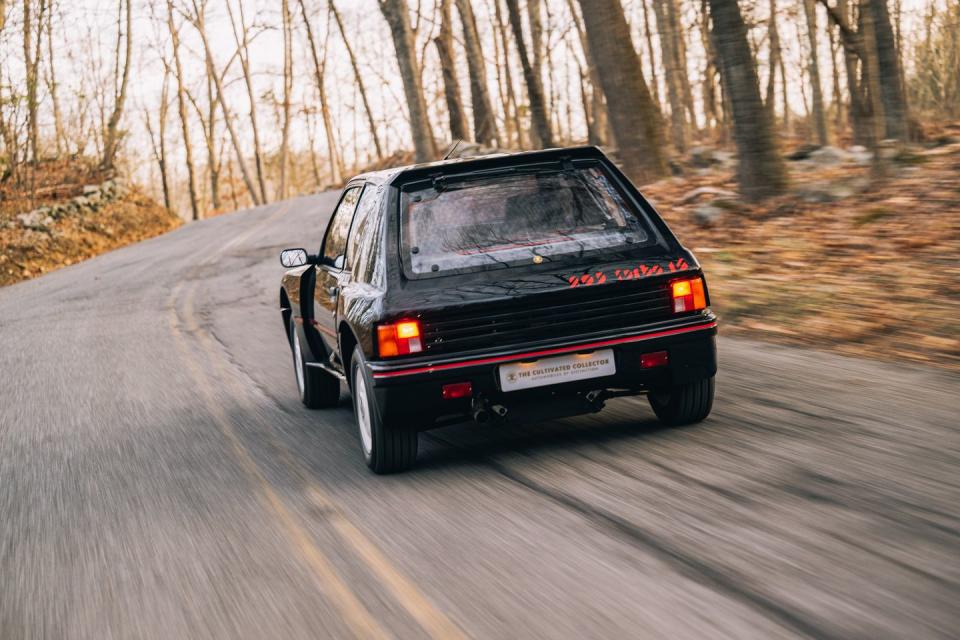
There’s not a lot of postscript on the 205 T16 to latch onto, either. Peugeot brought this car out in late 1984, won nearly every rally it entered that season, won the 1985 championship, won the title again the next year, and then Group B disbanded. Only in the late-Nineties did Peugeot field a top-rung car in the WRC again. This 205 T16 was a flash, a lightning bolt with a steering wheel.
To get the 205 T16, knowing two names are useful. Heuliez is first. It was the little shop Peugeot contracted to construct the 205 T16. Heuliez built and worked on prototype race cars, including the Peugeot-powered WM P88 that crested 250 miles per hour down the Mulsanne Straight at Le Mans. No car had ever gone as fast, no car has bested its record ever since. The 205 T16 might be shaped like an upturned shopping cart, but it was assembled by a very serious team with access to the most advanced technology of its day.

The second name to remember is Jean Todt. He ran the 205 T16 program for Peugeot, hired on to oversee the whole operation. We know his name better for other triumphs, like beating Audi at Le Mans, and turning Ferrari around with Michael Schumacher. This project was a quick turnaround. Todt started with nothing in December 1981 and before August 1984 was over, Peugeot was beating the Audi Quattro.
The car 205 T16’s team proved resourceful. The car’s engine is based on the four-cylinder Peugeot XU block, the same one it used for its diesel commuters at the time. The mill has a twin-cam head, 16 valves, Bosch fuel injection, a KKK turbo, and an air-to-air intercooler. It’s road spec was rated to 200 hp, with early race-spec engines producing 340 horses. Later E2 evolution models were so powerful engineers detuned them to 500 hp.
That engine pairs to a somewhat baffling all-wheel drive system. With the engine mounted transversely, sitting just aft of the passenger’s seat, the transmission—also mounted transversely—sits adjacent to the engine, located just behind the driver. A coupling from the transmission sends power to a central viscous diff, shuttling power between the car’s front and rear axles. On each axle sits another limited-slip differential sending the power to the wheels. Amazingly, the difficult brief of finding such a transmission wasn’t difficult at all for the French engineers. The Citroën SM routed power the same way. The SM is a front-wheel-drive machine, with its engine longitudinally behind the front wheels with the transmission ahead of it. Peugeot owned Citroën then, and simply used SM transmissions for the 205 T16. The whole car is something like a Citroën SM mounted sideways in the back of the 205 T16. The T16’s drivetrain split torque 34-66 front to rear, per Car magazine, and while it had much better weight distribution compared to the Audi Quattro, it had a tendency to tilt midair over jumps – the engine mounted on the right side of the car gave it a bit of a lean.

To turn a 205 into a 205 T16, Heuliez did the same as Autodelta with the Lancia 037 and Delta S4: they chopped it in half and welded together an entirely custom subframe, lengthening the wheelbase and dividing the car with a firewall and a plate of glass. It turns the front half of the car into a little space pod. Even though the cabin terminates right behind your head, the view ahead of you is civilian. It’s easy to get in and out of, comfortable, fires up instantly and idles without drama. All that sets it apart is the huge driveshaft humps and the orange Jaeger gauges, and the fact that it sits sky high on its alloy four-bolt wheels. It looks like it’s on stilts.
The 205 T16 sort of drives like it, too. There’s almost nothing 205 in this car, but it does feel akin to the 205 GTi from Peugeot’s same lineup. It is a kind of floppy machine. No, that’s rude. It’s a car that glides and floats, breathing over the choppy road beneath it. It makes you want to drive it harder and harder.
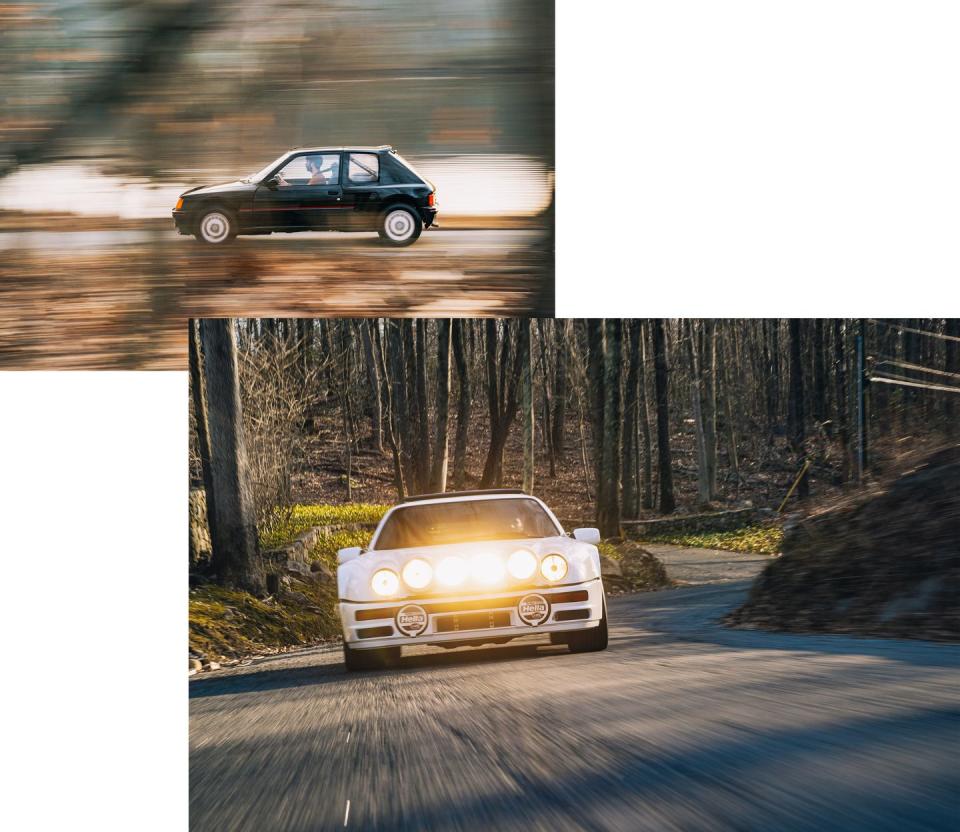
And while something like the 205 GTi has a spritely naturally aspirated engine, the 205 T16 takes it to another level with its turbocharger. The engine’s power band suffers so much turbo lag that the 205 T16 will hardly get up even a small hill if you find yourself in the wrong gear. I tell you nothing happens in this car below 4000 RPM. From there? It shreds. This is a genuinely quick thing on boost. There’s something in the 205 T16. Some kind of spark.
It’s amazing – this is a largely bespoke, two-seater, mid-engine sports car. It cost as much as a Ferrari at the time, too, only it looked like a hatchback, could tackle any logging road you threw at it, and had a 24-gallon fuel tank.
We had the 205 T16 at the end of the day, the low winter sun set against the little ponds and bogs of this rocky corner of Connecticut. Last light glinted on the roof scoop, as absurd a feature as any hatchback has ever had. The white wheels glowed, the boxy headlights gleamed. For a c built only to satisfy racing requirements and sold only to recoup a fraction of the race team’s sprawling budget, this is a remarkably well put-together road car. The doors have a fine sound to them, the bolstered bucket seats are well trimmed. Heuliez turned out concept cars for Peugeot, also, and this has some of that whimsy.
Again, it is easy to drive, its thin steering wheel just like any other 205’s, emblazoned with ‘TURBO 16” as audaciously as one would hope for an Eighties product.
And just the same, driving it slowly reveals none of its frantic character. Off-boost, it’s a car. Light and tall and comfortable. The visibility is outstanding, hilarious only when you look over your shoulder to see another set of gaping intakes, one on each pillar behind the side glass.
The boost feels extraordinary. It’s only 200 hp, but they all arrive as a thud, a wave, a crescendo. It is only lightly comical that the gear lever is as pedestrian as it is in any 205, shaped like an old umbrella handle but linked to one of the most intricate and advanced pieces of Eighties racing tech.
This road that the Cultivated Collector has taken us to is a short stretch in between villages, empty but for boulders and trees, gritty and potholed. It is not a Corvette road. It is not a Ferrari road. Turns are off-camber and over crests. Only one turn is fast, coming down off a big compression. The Peugeot absorbs it all like a sponge. You’re not driving a car; you’re corralling a set of suspension components harnessed to a turbocharger. It leans and rolls and sets and disappears. Nothing about the car is intimidating behind the wheel, nothing obtuse or difficult to grab. I get why this thing dominated.

RS200 is a different creature. If the Peugeot has an analogue in the Renault 5 Turbo before it, the RS200 draws a clear line back to the Stratos. Both were drawn up from a clean sheet to win rallies. There is no economy car the Lancia and Ford are meant to look like; both were free designs from Italian coachbuilders. Lancia worked with Bertone, Ford with Ghia, which it had recently purchased. Both slot the engine behind the driver, and both use fiberglass for their low-volume production bodies. Lancia took its engine from Ferrari, Ford from Cosworth, in its case turbocharging the legendary BDA four-cylinder that made the MkII Escort a legend (and a championship winner in 1981.)
While the Stratos is relatively simple, basically a sports prototype with a short wheelbase and long-travel suspension, the RS200 had a more challenging design brief. It needed a turbo, adding a great deal of complexity in intercoolers, wastegates, and all the assorted piping they required. It also needed four-wheel drive, a tall order for a mid-engined car. Ford elected to route power from the rear-mounted transmission forward to a transfer case at the front of the car, then back again to the rear axle via a second driveshaft. This was, I suppose, better for weight distribution. That might be true in theory, but for the most part all of this complexity in design handicapped the car in practice. RS200s had a horrible record for reliability, usually attributed to transmission issues, as Group B Rally Shrine notes.
If anything, the RS200 needed a few years of development to get its act together, years that it never got. In March of 1986, in Portugal, the third rally of the season, an RS200 dodged a spectator standing in the road, lost control, and went off the road. A road lined with spectators. “Then… bump, bump, bump,” codriver Miguel Oliveira told Dirtfish years later, the moment that everything went wrong. “I didn’t see anybody. I didn’t see anything because everything was on the left side of the car. I felt the whack, whack, whack of the car hitting people.” Three people died, spectators, a mother and her 11-year-old son as well as another child. Some 32 others were injured, all watching the rally. It was only the first stage of the event. Two rounds later, after another fatal crash, Group B got the ax, and the RS200 never won a championship.
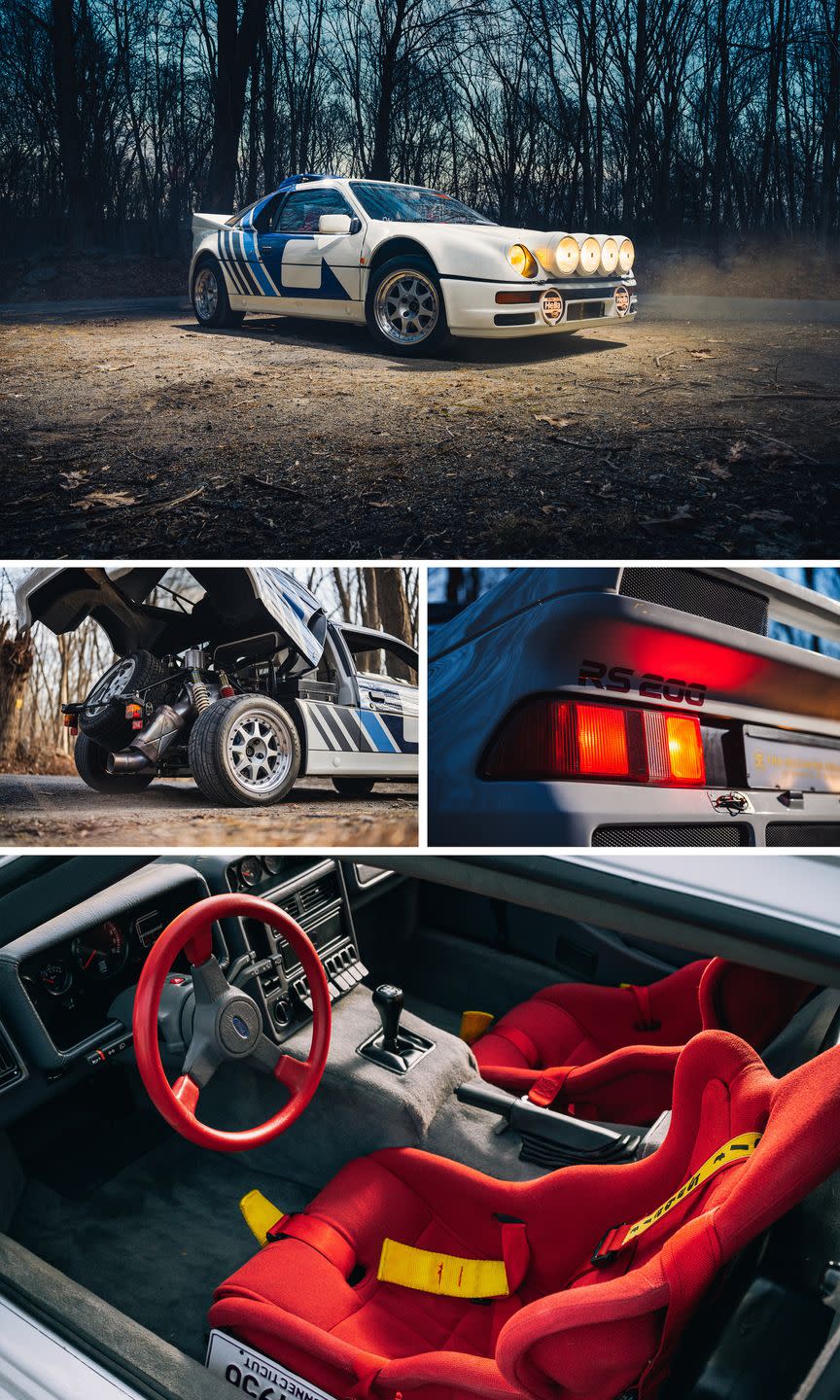
From the moment the car fires up, though, it feels like a title-winning machine. Hell, before it starts, the car feels like a champion. This particular RS200 is an evolution model, and in race spec, and it drinks from a can of race gas, the otherwise clear air of New Canaan suddenly burning sweet. While the 205 T16 idles evenly as a road car should, the Ford is rough, stuttering, ear-shatteringly loud. This car is running a triple-plate clutch and a dog box transmission. To slot it into gear takes real force, or else the gearbox will explode. The RS200 takes long minutes to warm up enough to drive at all, and even longer on the road to get the transmission and engine up to temperature.
And with that first full crack of the throttle, the world splits in half. Your eyes blur, twin shocks at each rear corner compressing under the acceleration. This thing is running at full race power, 450 HP from its 1.8 liters. It is high strung and lets you know it. The lag from the turbo is immense, and power comes on like a grenade.

What seemed like a lot of prep to get this car going suddenly seems minute. This is a car with the force and presence of a prototype race car. And it has a license plate. And it doesn’t take a full race crew to get it out of your garage.
There is no amount of driving I can do that can reach the limit of this car. The RS200 eats the pavement ahead of it. Swallows it whole. All of those delightful crests and swoops and bends that I savored in the 205 T16 are now obstacles. This car only wants to go fast. It wants to go as fast as possible. It grumbles and grunts and stutters at any pace less than flat out. It is a car to drive to the end of the Earth, and it has the suspension travel to do it. The RS200 is not a plaything for sweet enjoyment. It is a tool for speed, meticulously crafted to crush roads into oblivion. There is no sensation of how it takes a corner. There is no handling, not as I can surmise at these less-than-race speeds. I can only imagine it sideways in the snow in Sweden, where in 1986 it got its best finish, placing third.
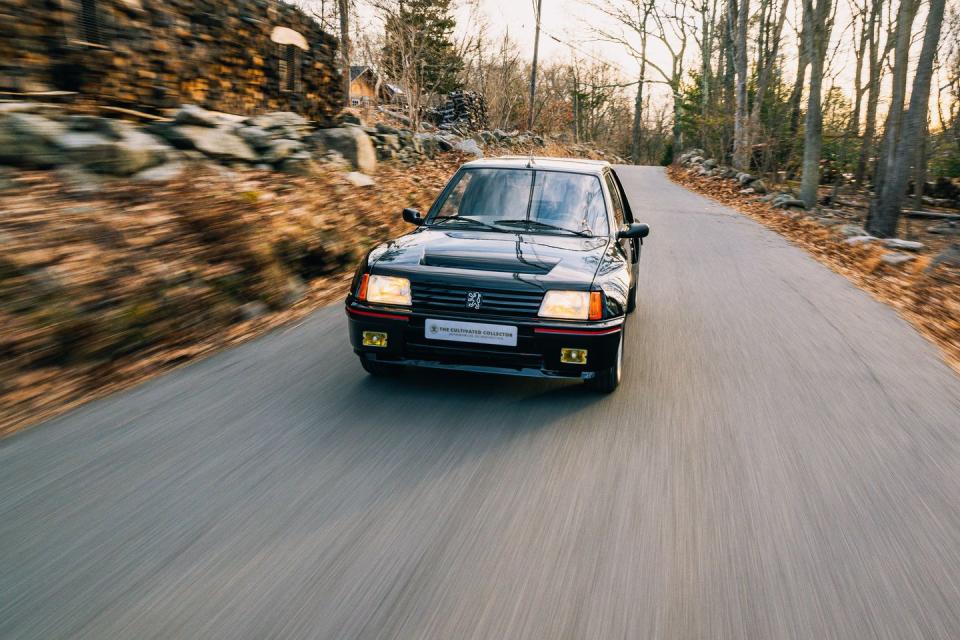
With an abundance of charm, the interior has much more handcrafted sense to it than the Peugeot. Everything is chunkily padded, parts more clearly pulled from various parts bins. The doors, I don’t know why I even have this committed to memory, are cut down from Ford Sierra stock. It’s not that Ford just threw the RS200 together, rather that you can see the company was trying to dress up parts to make them feel special. The bright red seats match the bright red steering wheel. With Ford’s blue oval in the center, ahead of yellow Sabelt harness. Everything is filled with a warmth only primary colors provide.
There is no way to reconcile the anger of the car with its almost delicate face. It has two round little headlights on either side, a cheery little frog ribbiting down the road. It also has six rally lights mounted between the headlights, enough lumination to spot a moose three counties away. It is a weird mix of quiet and extreme, equal parts startling and adorable.
Looking at the RS200, its rear clamshell up, offers yet another strange contrast. As delicate as the bodywork is (manufactured by Reliant of tippy three-wheeler fame), the business end of the car is as brutish as imaginable. The frame is stout and hulking, the engine is more turbo than block, and the four coil shocks block your view at much else. It’s a truck. It’s the world’s fastest truck.
Weirdly, as hardcore as the drivetrain of the RS200 is, they all shipped with power steering. It is absurdly light, and remarkably easy to maneuver. The Renault 5 Turbo II steers like a brick by comparison.
The RS200 is too incongruous to grasp. An afternoon is not enough time with it. This is a jewel, one of the most fascinating cars of the modern era. It brushed against greatness; you can sense it from behind the wheel.

Group B rally cars of the 1980s still seem extraordinary – these are the cars that were too fast for rallying, cars that shot flames and parted crowds like the Red Sea, and crashed and burned and killed and were banned – but what happened to them is not all that uncommon in the history of top-flight motorsports. It happened to sports cars in the 1960s, with the top class prototypes getting legislated down from five liter engines, to three liters, and when that wasn’t enough to curb the terrifying speeds of cars like the Porsche 917, GT cars got the same knockdown as well. Formula 1 rarely goes more than a few years before it cuts engine sizes or tightens aero packages to slow things down.

What, then, was so different about Group B? The real danger came in what wasn’t changed.
Group B regulations, introduced in 1982, didn’t radically depart from the Group 4 regulations that preceded them, except for one dramatic change. To homologate a car for Group 4 racing, you had to prove that you’d built at least 400 production cars in a year. Group B regs cut that number in half to 200, and if you wanted to homologate an “Evo” version, you only needed to build 25 production cars to make it legal. Group B uncorked rallying, and any unhinged idea a race team could dream up was that much easier to design, build, and certify. All-wheel drive took over, turbo boost skyrocketed, and what had been relatively tame Group 4 cars became 500-horsepower monsters that were experimenting with Formula 1 technology. Speeds skyrocketed. This minor rule change in homologation requirements had fundamentally altered the cars that competed in the World Rally Championship.
What didn’t change were the rallies themselves. These events were devised in an earlier era, when rallying was less about going as fast as possible as simply making your way to the finish line. Let’s take, for example, the first Monte Carlo Rallye of the WRC era, 1973. Over the course of a week, competitors covered 456.5 km. A decade later, when Group B is starting to see its first great rivalry of Audi vs Lancia, it still took a week to run the Monte, and it covered 709 km. The last Monte under Group B, 1986, was even longer, a staggering 867 km. Even as speeds shot up, as rally cars grew hairier, faster, and harder to handle, rallies weren’t shortened to make up for this increased effort. Nothing was done to reduce fatigue. This years’ Monte? Competitors need only to cover 325 km. It’s an appropriate cut given how quick modern WRC cars are. Group B rally meant running supercars with more power than a modern WRC entry, but on events designed for what we’d consider vintage sports cars. The 1986 Tour de Corse, where the great rising talent of Henri Toivonen died in a crash “so severe that the car exploded and was consumed by an intense fire,” as Autosport reported at the time, was 1000 km long. The Rallye Côte d'Ivoire was 3763 km, the Safari Rally 4190! These were sprinters being forced to run a marathon.
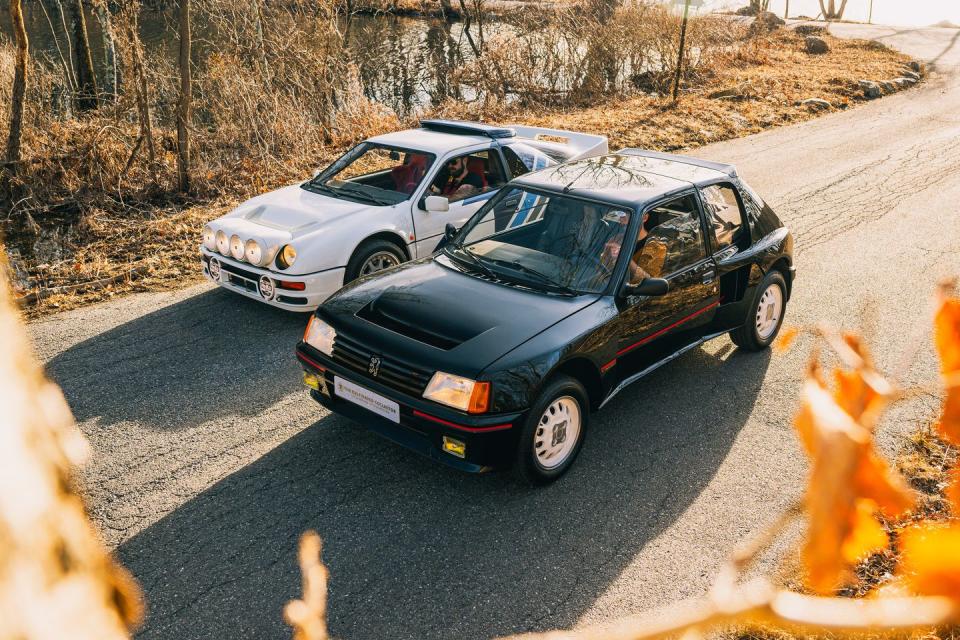
But the length of its rallies alone wasn’t what made Group B so dangerous. More than anything it was a victim of its own success. These cars were so cool, so fascinating, so alluring, that people absolutely flocked to see them. To hear an Audi Quattro’s turbo flutter chirping through the forest is one thing. To see a Peugeot 205, not unlike the ones running errands to the grocery story in your European village, with a wing bigger than you’ve ever seen, shooting fireballs, air intake gasping through a giant hole in the side panels, shredding sideways and beating that Quattro is another. People wanted to bear witness. People wanted to touch these cars. It’s a fact of rally that crashes do happen and drivers die. It is not common, but it happens. It’s a risk everyone signs up for when they strap into these cars, roll cages and all, and howl past trees and rocks and cliffs. Spectators dying in rallying is unacceptable, and when Group B cars started plowing into crowds, everything got shut down.
I wondered if these cars, this particular RS200 and 205 T16, would retain some of that fearsome presence in driving them. Yes! They do! Everything about them. Their tightly packaged turbo engines feel endlessly complex, wedged into their raw and simple tube subframes, with cute and cheery faces smiling ahead in complete contrast. Lift up the rear clamshell and you’re James Bond looking at a bomb he has to diffuse. Step inside, turn the key and they roar. They’re imposing. Until you start driving them. Their anger is contagious. Their acceleration under boost is addictive. From behind the wheel of a Group B special, no road is twisty enough, rough enough, long enough.
You Might Also Like

 Yahoo Autos
Yahoo Autos 